|
| |
- This page contains pictures and information about Hover
Flies in family Syrphidae that we found in the Brisbane area, Queensland, Australia.
-
 - Hovering above my head
-
- Hover
Flies in family Syrphidae are common in Brisbane as well as in
Australia. They are very good fliers. Most of them are good in hovering. They
can stay motionless in air.
-
-



- Eristalinae
Microdontinae
Syrphinae
-
- Like most other flies, Hover Flies have very large eyes and short antenna. They have one pair of wings which are
usually clear in colour. Hover Flies can be recognized by their wing
vein patterns. M branches do not reach wing margin but but run in parallel
with wing margin.
-
- Hover Flies are also known as Flower Flies. Some species are called Drone
Flies. Hover Flies may sometimes be confused with stinging bees or wasps.
Their
mimic colours (Batesian
mimics of Hymenoptera) make them
look like bees or wasps. Their bodies are slender. They are from small to medium in
size. On their abdomen there
are the yellow-black bends and narrow waist mimic patterns. Some species
resemble muscoid flies. Hover
Flies visit flowers as bees and
wasps. They are major pollinators of
some flower plants. They are usually seen hovering or resting
on flowers.
-
-



-
- The adult Hoverflies feed on nectar and most are the important pollinators of plants. We sometimes see the Hover Flies searching for the
aphids on plants. Beside
nectar, Hover Flies feed on honey dew produced by aphids as well.
-
 
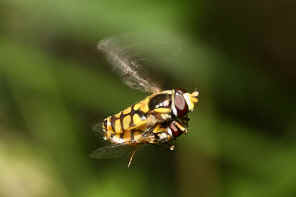 - Larva hunting aphids
Pupa
Photo thank to Trevor Jink
-
- There are three subfamilies of Hoer Flies and they have very different life-histories.
Some species larvae are predators of many soft body insects such
as aphids, scale insects, thrips and caterpillars. Some species
of Hover Flies lay eggs near the aphids colony. Their maggot-like larvae are
the predators of aphids. For details of this Hover Fly life-cycle information please
click on here. Some larvae in this family live in ant
or bee nests where they live as scavengers
or predators.
-
- Both Hover flies and Bee Flies (Bombyliidae)
mimic bees and wasps.
Bee Flies have longer wings while Hover Flies have shorter wings with a series of
closed cell on the wings hind margins.
- Eristalinae - Drone
Flies, Rat-tailed Maggot
- This subfamily has the widest range of larval habitats. Most Eristalinae larvae are saprophagous.
They live in sap trails, under bark, in rot-holes in trees and in decaying organic material such as dung and compost. Some live as scavengers on the remains of insects and other material. Others are leaf miners, tunnel in stems and root. Some are
specialize on wax-secreting aphids. Some are parasitoids in wasp or bees nests. Some known as rat-tailed maggots and are aquatic.
-

-
 
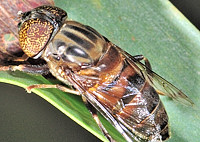 
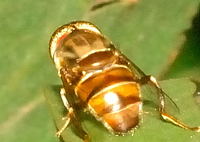
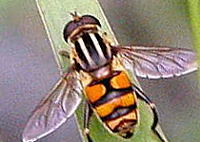 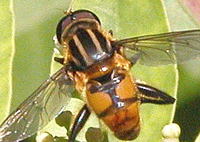
-
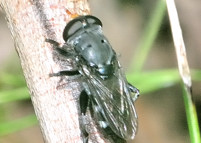


-
-
- Microdontinae -
Wasp-mimic Hover Flies
- The hover flies in Subfamily Microdontinae have antennae directed anteriorly and usually
long, but diverse in structure in different species. Head is board. The eyes
are bare and wide apart in both sex. They are stoutly built, closely resembling bees or wasps.

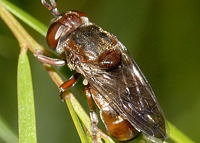
-
-
- Syrphinae - Slender Hover
Flies
- Hover Flies in this subfamily Syrphinae are from small to medium in size.
They have slender body and short antenna. Most of them mimic small bees or
warps with yellow and black bands on abdomen.
-
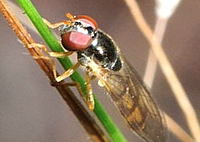 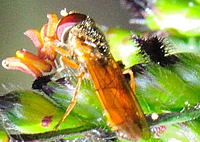
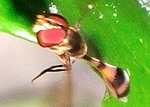
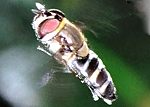
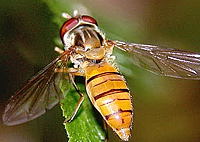

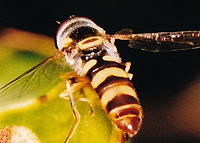


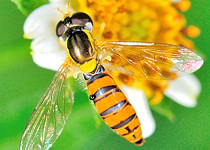
-
- Reference:
- 1. Insects
of Australia - CSIRO, Division of Entomology, Melbourne University
Press, 2nd Edition 1991, p763.
- 2. Insects of Australia and New Zealand - R. J. Tillyard, Angus
& Robertson, Ltd, Sydney, 1926, p368.
- 3. Family SYRPHIDAE -
Australasian/Oceanian Diptera Catalog - Web Version, by F. Christian Thompson & J.R. Vockeroth, 2007.
- 4. Syrphidae - Graeme's Insects of Townsville, Australia.
- 5. Family SYRPHIDAE - Australian Biological Resources Study, Australian Faunal Directory.
- 6. Northern
Territory Insects, A Comprehensive Guide CD - Graham Brown, 2009.
- 7. Flower Flies (Syrphidae)
- Flower Flies (Syrphidae), LIFEDESK COMMUNITY.
-
- Back to Top
-
- [ Eristalinae ] [ Microdontinae ] [ Syrphinae ] [ Others ]
| |
|































